 |
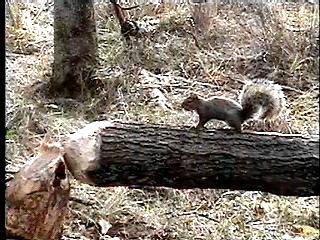 |
 |
 |
Beavers and Trees: Part Two
Beavers don't have very good eyesight. I think many of them are virtually blind, certainly the beaver below was blind, as I saw it continually bump into things

which goes a long way toward explaining why they are not as in awe of trees as we are. They can't see a tree's glorious crown and its stately beauty. They just smell food. I like the photo below because it shows the beavers lack of discrimination.
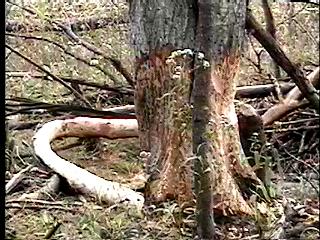
The inner bark of the large standing trees is the same as the bark of the small curved tree that had been brought to the ground. Perhaps, their poor eyesight also explains their dogged determination when felling trees. If they could see how likely it was that the tree they were cutting was going to get hung up on another tree, would they even try?

Can you see the beaver still working on a rather large red oak that might have easily crushed the beaver had the tree not been entangled and held up by an even larger red oak? Indeed, generally beavers don't continue working on a tree when it is being held up by a thin column of heart wood. This red oak
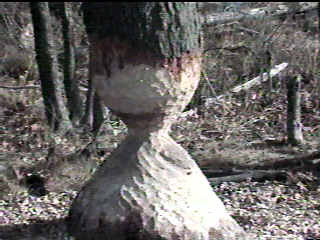
stood like this for a week or so before a strong wind blew it over allowing the beavers to get to its bark and branches.
Every time I've watched a beaver cut a middling sized tree, say over six inches in diameter, the tree didn't fall without further effort.
 |
 |
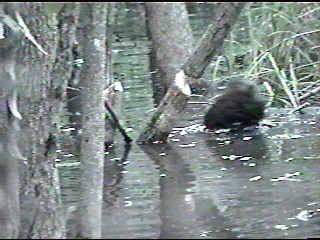 |
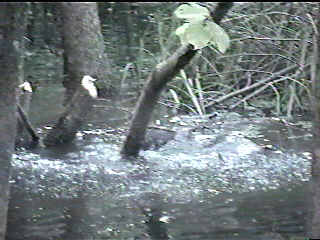 |
The beaver cut the tree and it fell into other trees, so the beaver cut it again and it remained hung up until the beaver pushed and pulled and brought it down to the pond so it could feast on its leaves.
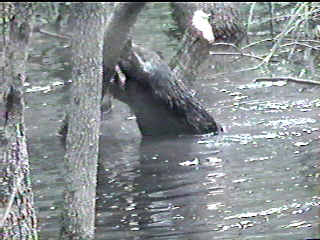 |
 |
 |
 |
Sometimes the beavers resort to a second cut in vain, especially with larger trees that they can't push and shove.

Yet I think it is a mistake to mock beavers for cutting trees that can't fall to the ground. While the beavers fail to bring the crown of the tree down, with all its delicious twigs and leaves, once the tree dies more light comes to the ground increasing the likelihood that saplings will sprout up that the beaver can, in time, eat. It is not uncommon with sugar maples especially to find a central stump or trunk of an old dead tree surrounded by a half dozen or more smaller trees growing from the old trees roots. In the photo below, the ash hung up in another tree; the maple fell to the ground.

When trees of roughly the same size, so close to each other, have such varying fates after being cut, better the beavers not worry about the science of getting a tree down. Better that they cut all they can and take their chances.
Perhaps I am giving too much of an impression that beavers are indiscriminate, almost inanely mechanical in the harvesting of trees. Once the tree is down and completely accessible to the beavers, they begin dealing with it in terms we can all understand. Generally they cut the branches first

and often use them as a kind of carry-out meal, dragging then to the lodge or the dam.
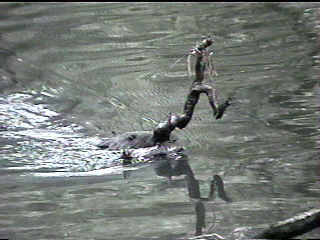
Needless to add, the branch will often have a dual use. I've seen beavers push up leafy branch on the lodge, eat its leaves, and then move on. In the fall branches will be sunk in front of the lodge to form a larder of food for the winter.

But now, I am making beavers sound too sensible. Beavers will often cut the branch and segment it into small logs and then leave the logs behind, for years. Putting the best light on it, I think of these left behind logs and trees as a kind of unconscious insurance policy. Like beavers, I cut and collect wood on some land, only I cut dead or dying trees and then cut them into long logs, carry them to a central saw pit by the road, cut them into small logs, split them and take them home to burn in the wood stove. I find that I almost always leave logs behind! The obvious reason is that as I hike around I get distracted by other dead trees that for various reasons I gave higher priority for harvesting. But there is also a comfort in rediscovering work I had left half done -- and I often stumble upon these piles a year later. That way I can look at my piles of split wood and think that's just the half of it.
Beavers seem to make a system of being unsystematic. I would not be surprised if scientific studies prove that beavers vary their foraging to optimize the nutritional value of what they eat, so that, say, ironwood in the spring, cherry in the summer and sugar maple in the fall makes perfect sense. Further, there is probably a formula to be discovered that can show how the diameter of the tree taken depends on the distance from the pond where the tree is to be taken. I wish I could diagram or illustrate a beaver colony's foraging pattern in a way that communicates my constant surprise as I discover where the beavers go and inspect what they take and what they leave behind.
Below is one of my favorite photographs

The beavers in this colony seemed to dislike white birch, until the winter when they stripped and sculpted this log. In general they range farther to get trees in the late spring and early summer when the ponds are most full. They seem to save many trees nearer their lodge in case drought constricts their ability to forage and transport logs. That said, some colonies go rather far from the pond in winter when the pond is frozen. Then the colony over the hill will prefer coming out from the under ice and taking the shagbark hickory right next to the hole rather than get ash a little ways up a snowy slope. Personally, I think the real key to foraging patterns, and the best predictor of what trees beavers will take, is the culture of the colony in question. The colony that feasted on shagbark hickory went on to fell some the next spring and summer. They developed a taste for it. Meanwhile, a colony that died out was surrounded by small shagbark hickories that they never even tasted. Once I noticed one colony taking out every red oak, while another left red oak and took ash.
Beavers also kill many tree by building dams and flooding a valley. Of course, they don't lose interest in a tree just because the pond water starts rising around it.

The beaver above recognized this flooded ash as an excellent tree to pull bark off. Evidently beavers use long strips of bark as bedding in the lodge. So just because there are many dead tree trunks in a pond without any sign of being gnawed, that doesn't mean the beavers didn't use them.
I suppose it might be possible to estimate how many trees beavers have to take in order to survive, but it bears remembering that beavers can go a long time without taking any trees. A telltale sign that beavers are interested in other things is when you see a very muddy pond. Those beavers are probably feasting on roots and grasses under the water. One year a colony fed on grasses for all of July and August and I was about to conclude that they swore off trees. Then in September they headed for the ridge and took down over a dozen large poplars and a half dozen large red oaks. Another colony seemed to subsist on ferns
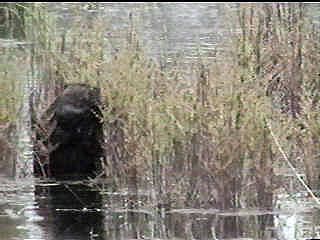
for a few weeks. And for all the heavy lumbering beavers might do. They seem most content to me when they are hunkered down in a shallow pond nibbling a small twig.
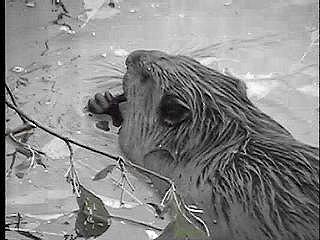
This page is maintained by Bob Arnebeck at